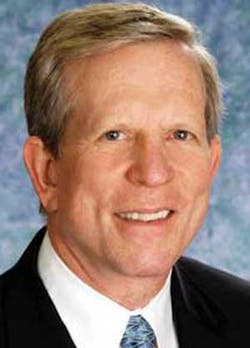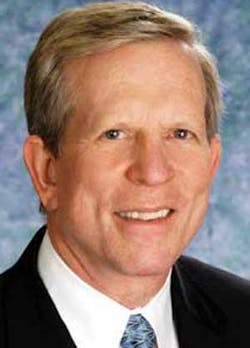Richard Fitzpatrick
By Barbara Goode
Discovery is seeing what everyone else has seen and thinking what no one else has thought. That statement, by Nobel Prize–winning biochemist Albert Szent-Gyorgyi, nicely describes why Richard Fitzpatrick MD has been able to make such an impact on cosmetic medicine. As one listens to him describe his work with lasers, the importance of Fitzpatrick’s keen power of observation–along with his vision and ability to carefully calculate risk–quickly becomes clear. These attributes have translated to tremendous benefit for patients and the field in general.
Fitzpatrick says that Dr. Leon Goldman, dermatologist, surgeon, and founding president of the American Society of Laser Medicine, who died in 1997, was a role model in this regard. “He was the true pioneer in laser medicine,” Fizpatrick says. “He used the same approach that I was taking: observing, looking for reactions, and thinking about different disease processes; thinking, ‘if it works here maybe it will work there.’ ”
Early in his career, Fitzpatrick had done skin cancer and cosmetic surgery of various kinds, and recognized that lasers would enable much less invasive treatment. Publications describing initial uses of argon lasers to treat birthmarks piqued his interest, and he purchased an argon laser in 1979. “When I got that laser I asked the company, ‘What are the uses, what are the settings, how do I use this?’ Basically they said, ‘We don’t really know. You come back and tell us what it’s good for and what the settings are.’”
Pulsing for safety and effectiveness
Up to that point, most of the work in laser medicine had been done at universities in very controlled environments. Then Fitzpatrick discovered the work of a New York-based plastic surgeon, Dr. Cosman, who was working to convert a continuous beam argon laser to a shuttered pulse to make it safer and to reduce scarring. “I thought that sounded like a great idea,” Fitzpatrick said, and he tried cutting the pulse substantially further. “I cut it down to 50 ms and got dramatically better results than anybody else; so much so that I thought there might be something unique about my laser. I had the company come out and check to make sure I was using the same thing everybody else was.”
The pulsed delivery enabled him to avoid causing scarring in a patient. “I had done some biopsies to show I could confine the heat more specifically to blood vessels and not give generalized heating throughout the dermis, which is what was causing scarring,” he says. “But nobody believed it. I submitted a paper to the Archives of Dermatology and I didn’t have the physics background to be able to explain this, so it was just an observation on my part. They rejected the paper because they thought a pulse of 50 ms was no different than a continuous beam.” He was thrilled to discover Rox Anderson’s selective photothermolysis concept, which explained the results he was achieving. Anderson, by the way, would influence Fitzpatrick’s career more than anyone else, “because he has such incredible science knowledge as well as the medical knowledge. Any problem I pose to him, he can give me immediate theories.”
That was in the early 1980s, as Candela was developing the pulsed dye laser, and Fitzpatrick quickly volunteered to become involved with the company, doing clinical studies and basic studies with the pulsed dye laser for vascular lesions and alexandrite lasers for tattoo removal. He came to recognize the unreliability of modeling tissue from a purely physics standpoint. “Everybody knows this now but back then it wasn’t as clear: if you take those dynamics and put them into living human skin–which is very dynamic as far as blood flow, healing processes and water content–it changes significantly. Things you didn’t think would happen do happen, and things you thought would happen don’t happen. Most of my contributions were based on observation of what’s happening in tissue when you use the lasers.”
He recalls that tattoo removal at the time was hindered by the fact that red ink wasn’t in the range of available lasers. “I had a patient who had grotesque rouge cosmetic tattoos put on her cheeks,” he says, describing the unhappy outcome of an early cosmetic tattooing client. “The patient was in tears; she had no idea it would look this way,” he says. “We were using the 575 nm laser for blood vessels and I thought, ‘why not use that for tattooing?’ But the company wasn’t able to supply the laser in a Q-switched (pulsed delivery) form. They had a Q-switched 532 nm laser but cautioned that it wouldn’t penetrate deep enough.” Although nobody had ever tried it before, he decided the approach was worth trying. “It worked in one or two treatments and everybody was shocked. They didn’t think the wavelength would go deep enough. The tattoo ink goes as deep as 2 to 3 mm.”
Helping clients like this one, Fitzpatrick says, remains the most satisfying part of his work. “That’s the driving force of enjoying work every day.”
The benefits of heating collagen
Fitzpatrick was compelled by the CO2 laser because of its capability to both cut and coagulate capillaries simultaneously. This yields a huge benefit, providing a dry field so surgeons can see clearly, he notes. He was using lasers for eyelid surgery but conceived a new approach to skin resurfacing using the technology. The standard of care at the time for treating photodamage and scarring was dermabrasion, wherein a diamond-crusted wheel abrades away surface layers of tissue to reveal a healthier layer free of sun damage or scarring. But that method is less controllable. “It’s hard to tell how deep you are and it’s also very bloody; the blood is such that you can’t really see the field at all,” he explains. Another treatment method, chemical peel, has been unpredictable because so many variables are beyond the physician’s control. “If it penetrates too deep you get a wound that doesn’t heal properly and then scarring. To avoid that most people would treat more superficially but then you don’t get the results that you want.”
He reasoned that because laser penetration and heating depth is much more predictable, a physician should be able to calculate depth by number of passes. “I started playing around with that and realized that once you lost water in the tissue, that affects the dynamics significantly. We developed the procedure initially to avoid heat conduction, and to keep people out of trouble we kept [treatment] minimized to one or two passes. But as [the approach] developed it got out of my hands and people got way too aggressive without knowing what they were doing and ended up causing scarring and pigment loss.” Before long, many considered the procedure unpredictable and thus avoided it. “But it wasn’t the procedure itself that was unpredictable,” Fitzpatrick says. “It was the physicians using it.”
Fitzpatrick says his work with that procedure led to further exploration. He noticed that although he could safely treat an area with 10 consecutive passes of the pulsed CO2 laser, given adequate time for heat diffusion between passes, there was no real benefit after the third pass. “After the third pass nothing changed. It didn’t get any deeper, it didn’t vaporize deeper, we just hit a wall.” He relayed his findings to a laser physicist, who told him, “you just need a laser that has higher coefficient of absorption, and we have one–the erbium laser.” So he began working with the erbium laser as an adjunct to the CO2, to vaporize deeper. “I still use it in the way that I intended to years ago.”
Another thing Fitzpatrick noticed early on was how the CO2 laser caused tissue tightening. “I couldn’t figure out what was going on,” he recalls. “You could actually see the skin move when the laser contacted the skin. It was kind of scary!” As it turns out, he says, collagen’s triple helix has a unique thermal profile so that if you instantaneously heat it to 63°C, the bonds of the triple helix will change and the core will tighten. “As you continue heating, it falls apart and becomes debris but if you can heat it precisely to 63°C and not go above 70°C it remains intact. So I thought maybe we can heat collagen selectively underneath the surface of the skin and protect the epidermis and then be able to get nonsurgical skin tightening.” He explains, “As we started doing this I was watching very closely what was happening to the tissue because these were basically new procedures that nobody had really done and I wanted to be sure they could be done safely so I was paying close attention to the tissue interactions and my observations of the tissue interaction led to other developments.”
Future directions
That work ultimately led to testing of radio frequency to penetrate deeper into tissue than lasers, and Fitzpatrick has proceeded to experiment with focused ultrasound, a method he thinks has great potential for the future. He also sees potential for nonsurgical fat removal, which he notes won’t produce as dramatic results as surgery in a single procedure (though multiple procedures should be equally effective), but is safer with less downtime and healing time required. And, he says, “I still think that nonsurgical skin tightening is a procedure that can be further developed and perfected,” to provide greater safety for patients as well as less downtime and fewer complications.
He wishes that instrumentation suppliers had greater resources to do further testing before releasing a product to market. But “that’s a dream that’s not going to happen,” he says, noting how expensive these technologies are to develop. “So what ends up happening is, you find the minimally effective doses that are very safe and then those become the standard treatments. But in reality if you could push the envelope you could find a far more effective setting that would be much better in the long run.” Thankfully, Fitzpatrick will help fill the gap by continuing to observe, consider, and test–and we’ll all continue to benefit.

